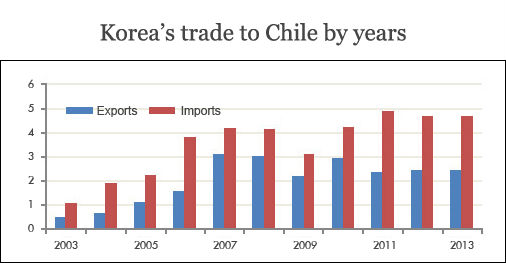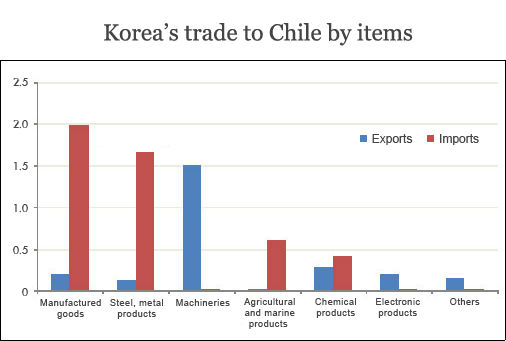-
 Korea.net's 24-hour YouTube channel
Korea.net's 24-hour YouTube channel- NEWS FOCUS
- ABOUT KOREA
- EVENTS
- RESOURCES
- GOVERNMENT
- ABOUT US
According to the Korea Customs Service, the trade volume between the two countries rose to USD 7.1 billion in 2013, from a beginning of USD 1.6 billion in 2003. Korea’s exports to Chile increased more than four times, to USD 2.4 billion in 2013, from USD 0.5 billion in 2003 just before the free trade deal was signed. Korea’s imports from Chile also showed a 4.5 fold-increase, rising to 4.6 billion in 2013, from USD 1 billion in 2003. Such increases are much higher than the rise seen in Korea’s overall trade volume, which showed only a 2.9 fold increase to USD 1,752 billion in 2013, from USD 372.6 billion in 2003. This suggests that the Korea-Chile FTA has largely contributed to an expanded trade volume between the two countries, said the Korea Customs Service.
Korea’s main export items to Chile-- automobiles, petroleum products, synthetic resin products and wireless communication devices-- showed more than a four-fold increase. In 2003, Korea recorded exports to Chile of USD 160 million in automobiles, USD 80 million in petroleum products, USD 50 million in synthetic resin products and USD 20 million in wireless communication devices. Ten years later, Korea’s exports to Chile in automobiles, petroleum products, synthetic resin products and wireless communication devices rose to USD 1,200 million, USD 200 million, USD 170 million and USD 90 million, respectively. In automobiles, in particular, it showed an eight-fold increase.

The blue columns show Korea’s exports to Chile by year. The red columns show Korea’s imports from Chile by year. (units USD 1 billion) (courtesy of the Korea Customs Service)

The blue bars show Korea’s exports to Chile. The red bars show Korea’s imports from Chile. Each pair is a separate category: Mining & Mineral Products; Steel & Other Metals; Machinery; Agriculture, Forestry & Marine Products; Chemicals; Electronics; and, Other. (units USD 1 billion) (courtesy of the Korea Customs Service)

Models pose with seedless green grapes imported from Chile during a promotional event at a supermarket in Seoul. Korea’s exports to and its imports from Chile showed more than a four-fold increase thanks to the introduction of the Korea-Chile FTA ten years ago. (photo: Yonhap News)
The volume of Chile’s exports to Korea also showed a remarkable increase, proving that Chile is also the beneficiary of the free trade deal. Some of Korea’s main import items from Chile, including copper goods, copper minerals, pulp and other metallic minerals, sat at USD 510 million, USD 220 million, USD 80 million and USD 10 million in 2003, respectively. By 2013, they had all risen, to USD 1,600 million, 1,600 million, 290 million and 200 million.
Agricultural products from Chile, such as grapes and pork, have also won high popularity in Korea. In the case of grapes, Korea’s imports showed a five-fold increase by weight, from 9,000 tons to 47,000 tons. In terms of price, however, that corresponds to more than a ten-fold increase, from USD 14 million to USD 144 million. In pork products, by weight Korea imported 15,000 tons of Chilean pork in 2003. That rose to 30,000 tons in 2013. By price, however, pork imports showed more than a three-fold increase, USD 30 million to USD 102 million.
Starting this year, both Korea and Chile will carry out additional tariff elimination measures to mark the 10-year anniversary of their bilateral free trade pact. Korea will reduce tariffs on more than 473 products, including some agricultural products, livestock, and marine products, such as pork and kiwis. Chile will also reduce tariffs on a total of 1,445 Korean products, such as industrial batteries and vacuum cleaners.
By Yoon Sojung
Korea.net Staff Writer
arete@korea.kr
Most popular
- First hearing-impaired K-pop act hopes for 'barrier-free world'
- Event 'K-Beauty Hang Out' draws hundreds in Philippines
- Ceremony in Seoul inducts 2,641 content creators of Korean culture
- 'Mad Max' director impressed by 'cinema-literate' Korean viewers
- Cultural spring festival Seoul Festa to start on May 1













